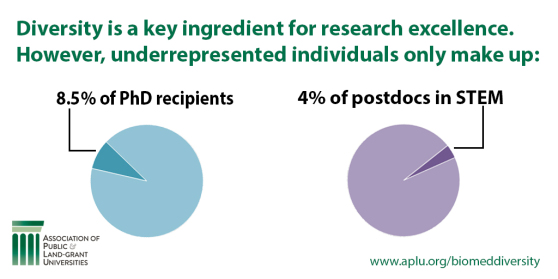Building a More Diverse Biomedical Research Workforce
By Julia Michaels
“There just aren’t enough minority scholars in the STEM pipeline.”
“Underrepresented students get so many scholarship offers, there’s no way our university can compete.”
“Until we fix our broken K-12 educational system, there’s little universities can do to expand minority student participation in science.”
Do any of these statements sound familiar? They are common refrains among higher education leaders, used to explain why – despite years of effort and millions of dollars in investment – underrepresented student participation in science fields continues to lag. The problem with these assumptions, however, is that they aren’t grounded in evidence.
One look at the numbers illuminates the depth of the diversity dilemma in higher education. According to recent data, only 8.5 percent of doctoral degrees were awarded to underrepresented individuals, and only 4 percent of postdoctoral scholars in STEM fields were from underrepresented groups. The lack of minority representation is concerning, especially since the United States is expected to become a majority-minority nation within the next few decades.

This persistent under-representation of minorities, women, people with disabilities, and the socioeconomically disadvantaged is extremely troubling. Diversity in the STEM and biomedical science workforce is critical for conducting quality research that will enhance our nation’s competitiveness. Studies across disciplines have demonstrated that diverse teams are able to solve complex problems more quickly and effectively than homogeneous ones. A diverse health and biomedical workforce aids the production of treatments and cures that are applicable to all patient populations while also enhancing patient satisfaction and trust, leading to more equitable health outcomes.
Although individual universities are making an effort to diversify research talent, promising innovations could benefit from broader testing. A stronger evidence base for successful interventions will enable universities to bring these strategies to scale and magnify their impact.
Yesterday, the Coalition of Urban Serving Universities (USU)/Association of Public and Land-grant Universities (APLU), and the Association of American Medical Colleges (AAMC) released a report intended to catalyze the process of improving evidence for successful diversity efforts. This report, the product of collaboration among 70 research experts at 28 universities, proposes actions that, if undertaken, will contribute to the body of knowledge that university leaders need to drive change across their institutions. Ultimately, this evidence base has the potential to alter how universities do business, increasing investment in practices that work and phasing out those that do not.
The proposed research actions will require deep collaboration across universities, academic medical centers, and national stakeholders. But as the opening statements above make clear, the lack of evidence is a significant barrier to change. We can do better – and these research actions are a good first step.
Read the full report
_____
Julia Michaels is Project Manager of the Learning Collaborative at APLU.
- Access & Diversity
- Research, Science & Technology
- STEM Education



Stay Connected
X (formerly Twitter)
Facebook
YouTube
LinkedIn
RSS